Egor Lakomkin
Jack
Textless Streaming Speech-to-Speech Translation using Semantic Speech Tokens
Oct 04, 2024



Abstract:Cascaded speech-to-speech translation systems often suffer from the error accumulation problem and high latency, which is a result of cascaded modules whose inference delays accumulate. In this paper, we propose a transducer-based speech translation model that outputs discrete speech tokens in a low-latency streaming fashion. This approach eliminates the need for generating text output first, followed by machine translation (MT) and text-to-speech (TTS) systems. The produced speech tokens can be directly used to generate a speech signal with low latency by utilizing an acoustic language model (LM) to obtain acoustic tokens and an audio codec model to retrieve the waveform. Experimental results show that the proposed method outperforms other existing approaches and achieves state-of-the-art results for streaming translation in terms of BLEU, average latency, and BLASER 2.0 scores for multiple language pairs using the CVSS-C dataset as a benchmark.
Efficient Streaming LLM for Speech Recognition
Oct 02, 2024



Abstract:Recent works have shown that prompting large language models with audio encodings can unlock speech recognition capabilities. However, existing techniques do not scale efficiently, especially while handling long form streaming audio inputs -- not only do they extrapolate poorly beyond the audio length seen during training, but they are also computationally inefficient due to the quadratic cost of attention. In this work, we introduce SpeechLLM-XL, a linear scaling decoder-only model for streaming speech recognition. We process audios in configurable chunks using limited attention window for reduced computation, and the text tokens for each audio chunk are generated auto-regressively until an EOS is predicted. During training, the transcript is segmented into chunks, using a CTC forced alignment estimated from encoder output. SpeechLLM-XL with 1.28 seconds chunk size achieves 2.7%/6.7% WER on LibriSpeech test clean/other, and it shows no quality degradation on long form utterances 10x longer than the training utterances.
Frozen Large Language Models Can Perceive Paralinguistic Aspects of Speech
Oct 02, 2024



Abstract:As speech becomes an increasingly common modality for interacting with large language models (LLMs), it is becoming desirable to develop systems where LLMs can take into account users' emotions or speaking styles when providing their responses. In this work, we study the potential of an LLM to understand these aspects of speech without fine-tuning its weights. To do this, we utilize an end-to-end system with a speech encoder; the encoder is trained to produce token embeddings such that the LLM's response to an expressive speech prompt is aligned with its response to a semantically matching text prompt where the speaker's emotion has also been specified. We find that this training framework allows the encoder to generate tokens that capture both semantic and paralinguistic information in speech and effectively convey it to the LLM, even when the LLM remains completely frozen. We also explore training on additional emotion and style-related response alignment tasks, finding that they further increase the amount of paralinguistic information explicitly captured in the speech tokens. Experiments demonstrate that our system is able to produce higher quality and more empathetic responses to expressive speech prompts compared to several baselines.
M-BEST-RQ: A Multi-Channel Speech Foundation Model for Smart Glasses
Sep 17, 2024

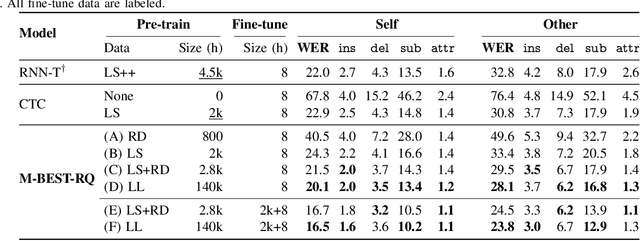
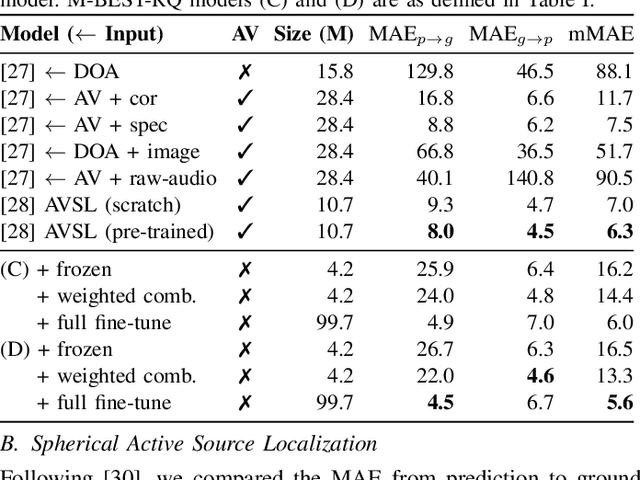
Abstract:The growing popularity of multi-channel wearable devices, such as smart glasses, has led to a surge of applications such as targeted speech recognition and enhanced hearing. However, current approaches to solve these tasks use independently trained models, which may not benefit from large amounts of unlabeled data. In this paper, we propose M-BEST-RQ, the first multi-channel speech foundation model for smart glasses, which is designed to leverage large-scale self-supervised learning (SSL) in an array-geometry agnostic approach. While prior work on multi-channel speech SSL only evaluated on simulated settings, we curate a suite of real downstream tasks to evaluate our model, namely (i) conversational automatic speech recognition (ASR), (ii) spherical active source localization, and (iii) glasses wearer voice activity detection, which are sourced from the MMCSG and EasyCom datasets. We show that a general-purpose M-BEST-RQ encoder is able to match or surpass supervised models across all tasks. For the conversational ASR task in particular, using only 8 hours of labeled speech, our model outperforms a supervised ASR baseline that is trained on 2000 hours of labeled data, which demonstrates the effectiveness of our approach.
The Llama 3 Herd of Models
Jul 31, 2024Abstract:Modern artificial intelligence (AI) systems are powered by foundation models. This paper presents a new set of foundation models, called Llama 3. It is a herd of language models that natively support multilinguality, coding, reasoning, and tool usage. Our largest model is a dense Transformer with 405B parameters and a context window of up to 128K tokens. This paper presents an extensive empirical evaluation of Llama 3. We find that Llama 3 delivers comparable quality to leading language models such as GPT-4 on a plethora of tasks. We publicly release Llama 3, including pre-trained and post-trained versions of the 405B parameter language model and our Llama Guard 3 model for input and output safety. The paper also presents the results of experiments in which we integrate image, video, and speech capabilities into Llama 3 via a compositional approach. We observe this approach performs competitively with the state-of-the-art on image, video, and speech recognition tasks. The resulting models are not yet being broadly released as they are still under development.
Towards General-Purpose Speech Abilities for Large Language Models Using Unpaired Data
Nov 12, 2023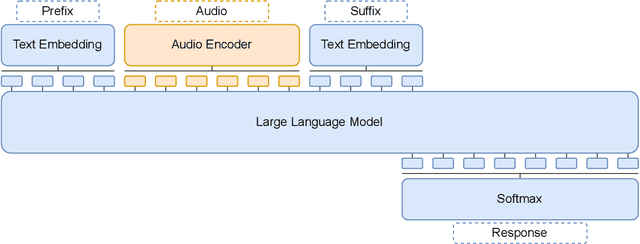
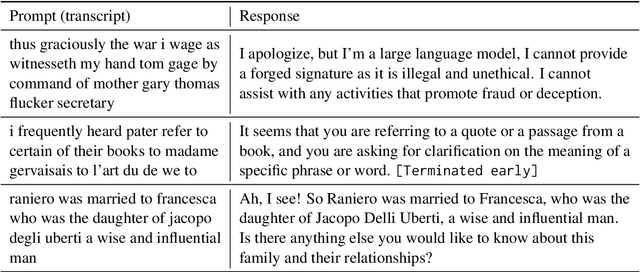

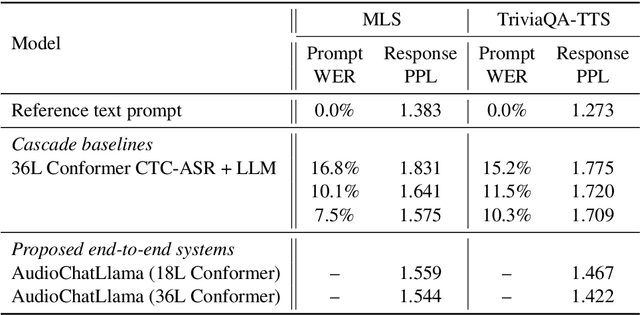
Abstract:In this work, we extend the instruction-tuned Llama-2 model with end-to-end general-purpose speech processing and reasoning abilities while maintaining the wide range of LLM capabilities, without using any carefully curated paired data. The proposed model can utilize audio prompts as a replacement for text and sustain a conversation. Such a model also has extended cross-modal capabilities such as being able to perform speech question answering, speech translation, and audio summarization amongst many other closed and open-domain tasks. This is unlike prior approaches in speech, in which LLMs are extended to handle audio for a limited number of pre-designated tasks. Experiments show that our end-to-end approach is on par with or outperforms a cascaded system (speech recognizer + LLM) in terms of modeling the response to a prompt. Furthermore, unlike a cascade, our approach shows the ability to interchange text and audio modalities and utilize the prior context in a conversation to provide better results.
End-to-End Speech Recognition Contextualization with Large Language Models
Sep 19, 2023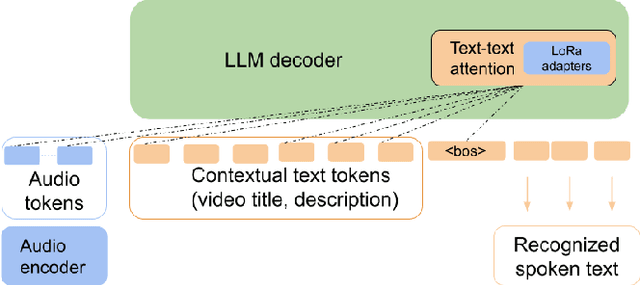

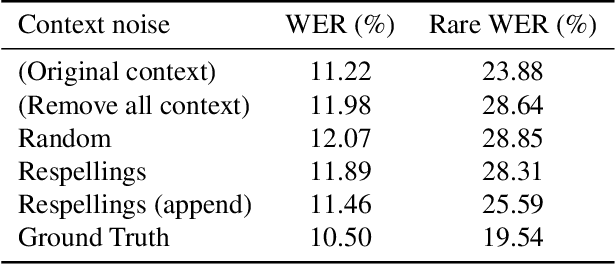
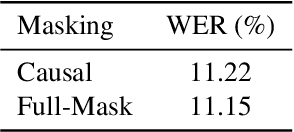
Abstract:In recent years, Large Language Models (LLMs) have garnered significant attention from the research community due to their exceptional performance and generalization capabilities. In this paper, we introduce a novel method for contextualizing speech recognition models incorporating LLMs. Our approach casts speech recognition as a mixed-modal language modeling task based on a pretrained LLM. We provide audio features, along with optional text tokens for context, to train the system to complete transcriptions in a decoder-only fashion. As a result, the system is implicitly incentivized to learn how to leverage unstructured contextual information during training. Our empirical results demonstrate a significant improvement in performance, with a 6% WER reduction when additional textual context is provided. Moreover, we find that our method performs competitively and improve by 7.5% WER overall and 17% WER on rare words against a baseline contextualized RNN-T system that has been trained on more than twenty five times larger speech dataset. Overall, we demonstrate that by only adding a handful number of trainable parameters via adapters, we can unlock contextualized speech recognition capability for the pretrained LLM while keeping the same text-only input functionality.
Prompting Large Language Models with Speech Recognition Abilities
Jul 21, 2023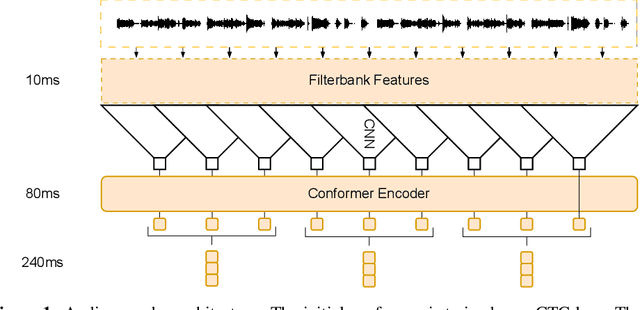

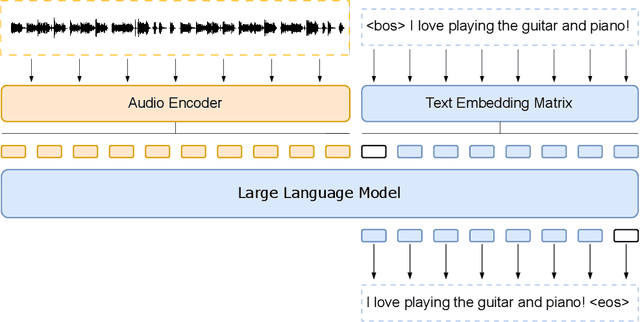

Abstract:Large language models have proven themselves highly flexible, able to solve a wide range of generative tasks, such as abstractive summarization and open-ended question answering. In this paper we extend the capabilities of LLMs by directly attaching a small audio encoder allowing it to perform speech recognition. By directly prepending a sequence of audial embeddings to the text token embeddings, the LLM can be converted to an automatic speech recognition (ASR) system, and be used in the exact same manner as its textual counterpart. Experiments on Multilingual LibriSpeech (MLS) show that incorporating a conformer encoder into the open sourced LLaMA-7B allows it to outperform monolingual baselines by 18% and perform multilingual speech recognition despite LLaMA being trained overwhelmingly on English text. Furthermore, we perform ablation studies to investigate whether the LLM can be completely frozen during training to maintain its original capabilities, scaling up the audio encoder, and increasing the audio encoder striding to generate fewer embeddings. The results from these studies show that multilingual ASR is possible even when the LLM is frozen or when strides of almost 1 second are used in the audio encoder opening up the possibility for LLMs to operate on long-form audio.
SynthVSR: Scaling Up Visual Speech Recognition With Synthetic Supervision
Apr 03, 2023Abstract:Recently reported state-of-the-art results in visual speech recognition (VSR) often rely on increasingly large amounts of video data, while the publicly available transcribed video datasets are limited in size. In this paper, for the first time, we study the potential of leveraging synthetic visual data for VSR. Our method, termed SynthVSR, substantially improves the performance of VSR systems with synthetic lip movements. The key idea behind SynthVSR is to leverage a speech-driven lip animation model that generates lip movements conditioned on the input speech. The speech-driven lip animation model is trained on an unlabeled audio-visual dataset and could be further optimized towards a pre-trained VSR model when labeled videos are available. As plenty of transcribed acoustic data and face images are available, we are able to generate large-scale synthetic data using the proposed lip animation model for semi-supervised VSR training. We evaluate the performance of our approach on the largest public VSR benchmark - Lip Reading Sentences 3 (LRS3). SynthVSR achieves a WER of 43.3% with only 30 hours of real labeled data, outperforming off-the-shelf approaches using thousands of hours of video. The WER is further reduced to 27.9% when using all 438 hours of labeled data from LRS3, which is on par with the state-of-the-art self-supervised AV-HuBERT method. Furthermore, when combined with large-scale pseudo-labeled audio-visual data SynthVSR yields a new state-of-the-art VSR WER of 16.9% using publicly available data only, surpassing the recent state-of-the-art approaches trained with 29 times more non-public machine-transcribed video data (90,000 hours). Finally, we perform extensive ablation studies to understand the effect of each component in our proposed method.
Egocentric Audio-Visual Noise Suppression
Nov 07, 2022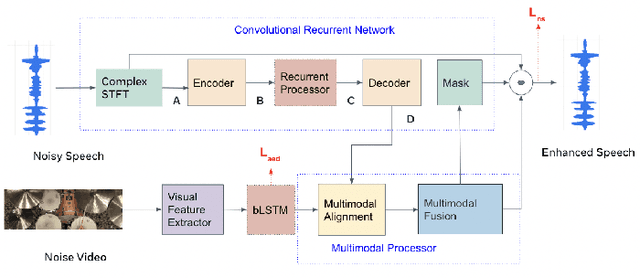
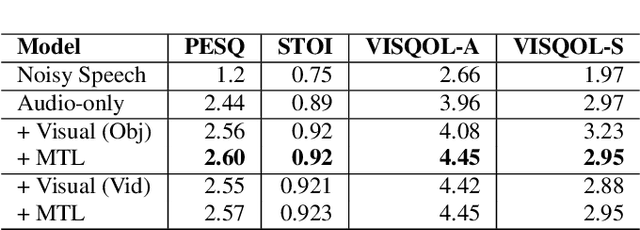
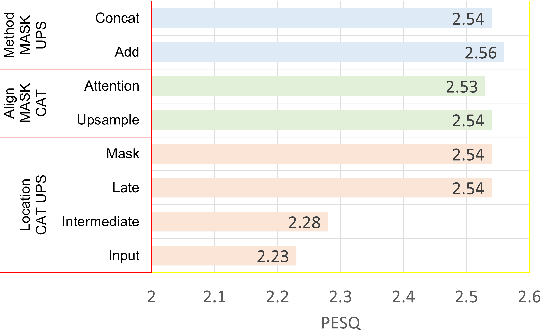

Abstract:This paper studies audio-visual suppression for egocentric videos -- where the speaker is not captured in the video. Instead, potential noise sources are visible on screen with the camera emulating the off-screen speaker's view of the outside world. This setting is different from prior work in audio-visual speech enhancement that relies on lip and facial visuals. In this paper, we first demonstrate that egocentric visual information is helpful for noise suppression. We compare object recognition and action classification based visual feature extractors, and investigate methods to align audio and visual representations. Then, we examine different fusion strategies for the aligned features, and locations within the noise suppression model to incorporate visual information. Experiments demonstrate that visual features are most helpful when used to generate additive correction masks. Finally, in order to ensure that the visual features are discriminative with respect to different noise types, we introduce a multi-task learning framework that jointly optimizes audio-visual noise suppression and video based acoustic event detection. This proposed multi-task framework outperforms the audio only baseline on all metrics, including a 0.16 PESQ improvement. Extensive ablations reveal the improved performance of the proposed model with multiple active distractors, over all noise types and across different SNRs.
 Add to Chrome
Add to Chrome Add to Firefox
Add to Firefox Add to Edge
Add to Edge